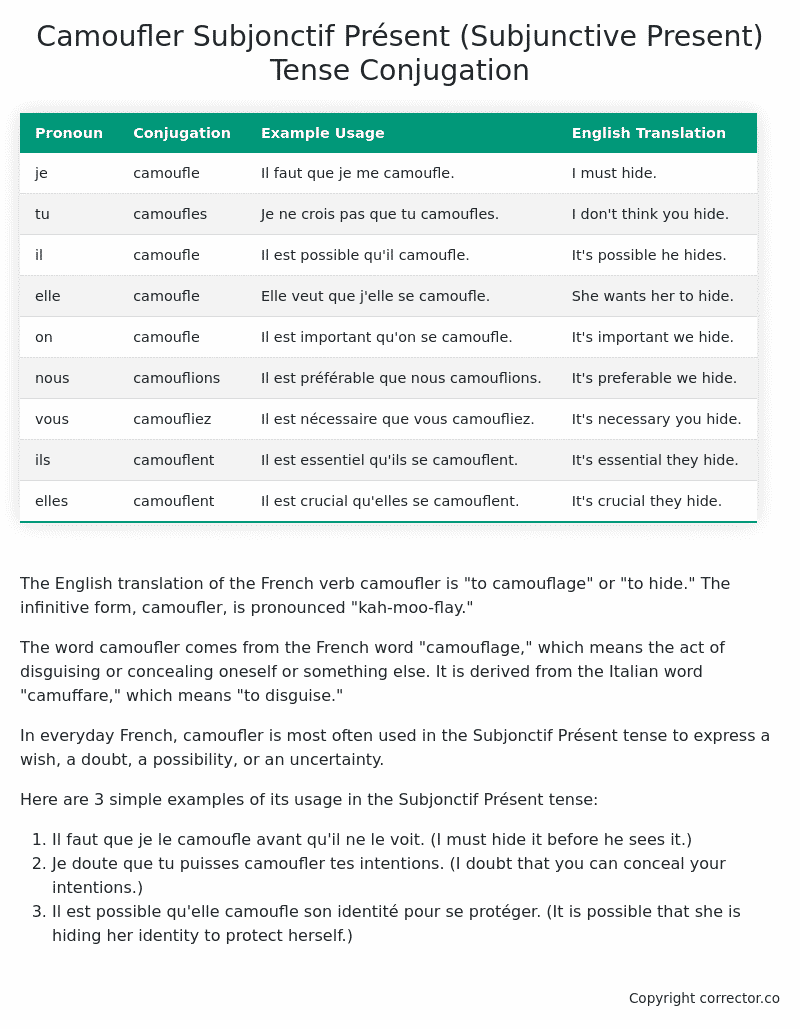Subjonctif Présent (Subjunctive Present) Tense Conjugation of the French Verb camoufler
Introduction to the verb camoufler
The English translation of the French verb camoufler is “to camouflage” or “to hide.” The infinitive form, camoufler, is pronounced “kah-moo-flay.”
The word camoufler comes from the French word “camouflage,” which means the act of disguising or concealing oneself or something else. It is derived from the Italian word “camuffare,” which means “to disguise.”
In everyday French, camoufler is most often used in the Subjonctif Présent tense to express a wish, a doubt, a possibility, or an uncertainty.
Here are 3 simple examples of its usage in the Subjonctif Présent tense:
- Il faut que je le camoufle avant qu’il ne le voit. (I must hide it before he sees it.)
- Je doute que tu puisses camoufler tes intentions. (I doubt that you can conceal your intentions.)
- Il est possible qu’elle camoufle son identité pour se protéger. (It is possible that she is hiding her identity to protect herself.)
Table of the Subjonctif Présent (Subjunctive Present) Tense Conjugation of camoufler
| Pronoun | Conjugation | Example Usage | English Translation |
|---|---|---|---|
| je | camoufle | Il faut que je me camoufle. | I must hide. |
| tu | camoufles | Je ne crois pas que tu camoufles. | I don’t think you hide. |
| il | camoufle | Il est possible qu’il camoufle. | It’s possible he hides. |
| elle | camoufle | Elle veut que j’elle se camoufle. | She wants her to hide. |
| on | camoufle | Il est important qu’on se camoufle. | It’s important we hide. |
| nous | camouflions | Il est préférable que nous camouflions. | It’s preferable we hide. |
| vous | camoufliez | Il est nécessaire que vous camoufliez. | It’s necessary you hide. |
| ils | camouflent | Il est essentiel qu’ils se camouflent. | It’s essential they hide. |
| elles | camouflent | Il est crucial qu’elles se camouflent. | It’s crucial they hide. |
Other Conjugations for Camoufler.
Le Present (Present Tense) Conjugation of the French Verb camoufler
Imparfait (Imperfect) Tense Conjugation of the French Verb camoufler
Passé Simple (Simple Past) Tense Conjugation of the French Verb camoufler
Passé Composé (Present Perfect) Tense Conjugation of the French Verb camoufler
Futur Simple (Simple Future) Tense Conjugation of the French Verb camoufler
Futur Proche (Near Future) Tense Conjugation of the French Verb camoufler
Plus-que-parfait (Pluperfect) Tense Conjugation of the French Verb camoufler
Passé Antérieur (Past Anterior) Tense Conjugation of the French Verb camoufler
Futur Antérieur (Future Anterior) Tense Conjugation of the French Verb camoufler
Subjonctif Présent (Subjunctive Present) Tense Conjugation of the French Verb camoufler (this article)
Subjonctif Passé (Subjunctive Past) Tense Conjugation of the French Verb camoufler
Subjonctif Imparfait (Subjunctive Imperfect) Tense Conjugation of the French Verb camoufler
Subjonctif Plus-que-parfait (Subjunctive Pluperfect) Tense Conjugation of the French Verb camoufler
Conditionnel Présent (Conditional Present) Tense Conjugation of the French Verb camoufler
Conditionnel Passé (Conditional Past) Tense Conjugation of the French Verb camoufler
L’impératif Présent (Imperative Present) Tense Conjugation of the French Verb camoufler
L’infinitif Présent (Infinitive Present) Tense Conjugation of the French Verb camoufler
Struggling with French verbs or the language in general? Why not use our free French Grammar Checker – no registration required!
Get a FREE Download Study Sheet of this Conjugation 🔥
Simply right click the image below, click “save image” and get your free reference for the camoufler Subjonctif Présent tense conjugation!

Camoufler – About the French Subjonctif Présent (Subjunctive Present) Tense
Formation of the Subjonctif Présent
Common Everyday Usage Patterns
Interactions with Other Tenses
Summary
I hope you enjoyed this article on the verb camoufler. Still in a learning mood? Check out another TOTALLY random French verb conjugation!


